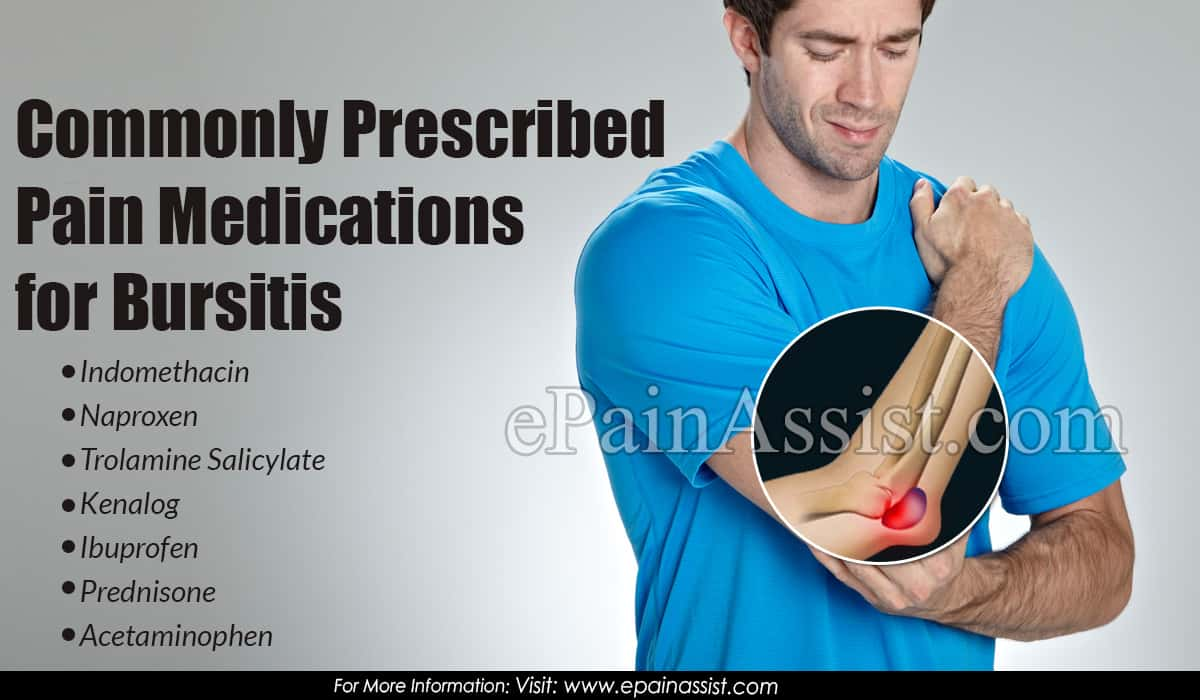Bursitis is an inflammation of the fluid filled sacs called bursa, which are located where the muscles and tendons glide over the bony surface. Elbows, knees, shoulders and hip are the areas that are mostly affected by this condition. Bursitis mostly occurs due to over usage. Sometimes, an injury is also the cause. Usually home remedies, physical therapy, exercises and rest are advised to reduce the inflammation of these sacs in the affected areas. However, often, home remedies and rest alone cannot treat Bursitis completely. Pain medication must be prescribed at those situations.

Commonly Prescribed Pain Medications for Bursitis
The general trend of prescribed pain medication for bursitis includes both the non-steroidal anti-inflammatory drugs or NSAIDs and the steroidal pain medicines, including the corticosteroid injections.
The usual line of treatment of bursitis includes the prescription and usage of NSAIDs or non-steroidal anti-inflammatory drugs. These are mostly oral medication that can reduce inflammation and swelling, especially in case of shoulder bursitis. Along with that, they can also reduce the pain. The medicines commonly prescribed to reduce the pain for bursitis are:
Indomethacin:
Sold under the brand name Indocin, this NSAID is also prescribed for managing the pain from bursitis. Usually the doctor prescribes a dosage of 75 milligram to 150 milligram a day, which should be divided into 3 to 4 doses every day. Once the pain is reduced, the doctor will also reduce the dosage for Indomethacin.
Naproxen as a Pain Medication for Bursitis:
This NSAID is sold under Naprosyn and Apo-Naproxen brand names. To manage the pain from bursitis, this medicine is prescribed at a 250 milligram dosage. The tablets of Naproxen are available over the counter in the name of Naproxen Sodium. Over the counter recommended dosage is, however, 200 milligram.
Trolamine Salicylate to Reduce Pain from Bursitis:
Sold as Aspercreme Cream, Trolamine Salicylate helps in reducing inflammation and swelling of joints and muscles. This topical pain reliever for bursitis must be kept away from the eyes, nose or mouth. To get the maximum effect of this medicine, you need to rub the cream right into the skin and make sure it is absorbed completely.
Kenalog for Bursitis:
Sometimes, when the pain is too severe and no ointment or oral painkiller can reduce the bursitis pain, the doctor may prescribe an injection to reduce the pain. In most cases, this injection is Kenalog. The injection consists of corticosteroid triamcinolone acetonide, along with a local anaesthetic. It is injected directly in the joint that is suffering from bursitis pain.
Ibuprofen:
This is the most commonly available NSAID that can be purchased over the counter by the names Advil, Mortin or Midol. Usually for regular dosage, you do not require a prescription for purchasing this medicine. However, if you need a higher dosage, it would require a doctor’s prescription. Ibuprofen is useful for any sort of bursitis pain that is mild to moderate. Therefore, for bursitis also, this drug is commonly recommended and prescribed.
Prednisone- A Commonly Prescribed Pain Medication for Bursitis:
When there is severe inflammation caused by bursitis, Prednisone is prescribed by the doctors. This is a corticosteroid. Usually the dose differs within a range of 5 milligram to 60 milligram, depending on the extent of the symptoms. As soon as Prednisone helps in controlling and reducing the symptoms caused by inflammation associated with bursitis, the doctor will reduce the dosage to the minimum possible level.
Acetaminophen:
When the pain from bursitis is mild, Acetaminophen is prescribed. This pain medication is sold under the brand name Tylenol. Usually Acetaminophen is prescribed along with other medicines and drugs that treat the swelling and inflammation associated with bursitis, as this drug itself is not an anti-inflammatory drug. Hence, it cannot reduce the swelling, stiffness and inflammation of the bursa. If you are taking this medicine, you must make sure that you do not drink alcohol during that phase. Acetaminophen together with alcohol can cause serious damage to the liver.
Conclusion
Although these are the most common pain medicines that are prescribed for bursitis, there are many other treatment options as well. It should also be mentioned here that taking proper rest is a must, when you are on these medications. This will let the inflammation and flare ups to be reduced and healed. If you resume to your regular activities too soon, it will again cause swelling and inflammation of your bursa.
Also Read:
- Hip Bursitis or Trochanteric Bursitis: Causes, Symptoms, Treatment, Exercises
- Ischiogluteal Bursitis Or Ischial Bursitis: Causes, Symptoms, Treatment, Exercises
- Iliopsoas Bursitis or Iliopectineal Bursitis: Causes, Symptoms, Treatment, Exercises
- Ankle Joint Bursitis: Causes, Symptoms, Treatment-Conservative, PT, NSAIDs, Surgery
- Massage Therapy for Trochanteric Bursitis: Benefits, Soft Tissue Massage
- Shoulder Joint Bursitis: Causes, Symptoms, Treatment- Conservative, PT, Surgery
- Home Remedies for Elbow Bursitis
- Home Remedies for Knee Bursitis
